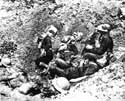French children watch the advancing column of an American Ammunition Train
Picture made in Soulosse, France, springtime 1918.
![]() Click on a small photo below - and you'll get the full picture.
Click on a small photo below - and you'll get the full picture.
![]() Click on the large picture - and you'll get a slide show.
Click on the large picture - and you'll get a slide show.

|
To the Front
US Colored Troops of the 92nd Division marching to the front in the Argonne-woods in France. |
|

|
Heading for the Argonne
An American tank colonne heading for the Argonne. |
|

|
Supplies Follow
The Supply Train of the US 129th Infantry, 33rd Division, on the road at Bethincourt. |
|

|
Advancing
Soldiers of the US 318th Infantry, 80th Division, advancing through smoke screens. Picture made near Le NeFour, France, on October 27, 1918. |
|

|
Bridgehead
A bridgehead at Chateau Thierry. On the picture troops of the US 7th Machine Gun Battalion, 3rd Division. |
|

|
Snipers
Snipers from the US 42nd Division. Picture made at Badonville, on May 18, 1918. |
|

|
In the salient
Soldiers from the US 167th Infantry, 42nd Division, have taken positions near St. Banoit in the St. Mihiel salient. Picture made on September 9, 1918. |
|

|
Pull
Tractor pulling a big gun to the frontline. |
|

|
Turned over
An overturned American 155 mm howitzer. |
|

|
In the Frontline
Yankee soldiers in the frontline, overlooking Nomansland. |
|

|
Café
American soldiers visiting a French café. |
|

|
Engaged
The US 167th Infantry engaged at Seringes in France. |
|

|
Cutting
American engineers clearing wire entanglements from a captured German position. |
|

|
Medals
Dutch-American sergeant Louis M. van Iersel with his breast full of medals - including the Medal of Honor. |
|

|
Resting
Fatigued to the bone US soldiers from the 121st Machine Gun Battalion, 32nd Division, rest in a shell hole. |
![]() To Page 2 with pictures of the American Expeditonary Force fighting in Europe
To Page 2 with pictures of the American Expeditonary Force fighting in Europe
![]() To the frontpage of The Heritage of the Great War
To the frontpage of The Heritage of the Great War